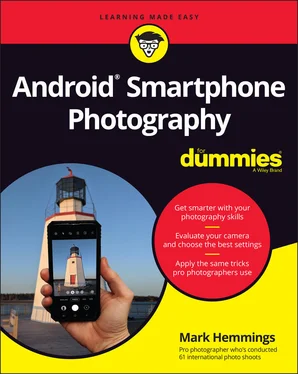Create the best landscape, sports, family, travel, products, and street photographs.
Edit, organize, and share your photos.
Create smooth-looking videos.
I wanted this book to work perfectly for users of all Android makes and models. As of this writing, there are 1,300 brands that produce over 24,000 distinct Android devices. And each brand is able to custom design the look and feel of their Camera app and settings. As it’s impossible to create a book that addresses the exact options of all 24,000 Android devices, I’ve been able to craft this book using the universal Google Photos app. The look of the Google Photos app is mostly consistent throughout all 1,300 Android brands. When the look of the Camera app differs slightly from manufacturer to manufacturer I make sure to explain that your own device may differ slightly in appearance to my examples. But not to worry! The differences are often as minor as the shape or color of an icon, and no more.
To reach the highest number of Android users possible, I created this book using three Android smartphones and both Android 10 and 11 operating systems. These three devices span three segments of the market:
The single lens Motorola Moto G7 Play using the Android 10 operating system. This budget phone won’t be upgraded to Android 11.
The single lens Google Pixel 4a using the Android 11 operating system. This mid-range phone will eventually be upgraded to Android 12 when the new operating system is released.
The Samsung Galaxy S21 Ultra 5G using the Android 11 operating system. This professional-level smartphone features a very high quality multi-lens camera system.
It’s possible that you have a phone from a different manufacturer, such as HTC, Xiaomi, or Sony. As the pre-loaded Google Photos app is universal in its appearance and functionality, you will be more than fine following along with each tip and technique.
It’s also important to mention that I took all the photography examples in this book with my previously mentioned three Android smartphone models.
This book assumes that you may know nothing about smartphone photography, yet is also highly accessible and valuable to those who may consider themselves as advanced amateurs. Android Smartphone Photography For Dummies guides you through the best practices of mobile photography, helping you gain a new creative outlet to express yourself!
So to start you out on a path to photographic success, I assume that you
Have an Android smartphone and its operating system is up to date.
You have access to Wi-Fi or use a data plan with your mobile phone provider.
Other than these two presumptions, I explain everything else in the book in great detail so that you never feel overwhelmed or bogged down.
This book, like all For Dummies books, uses icons to highlight certain paragraphs and to alert you to particularly useful information. Here’s a rundown of what those icons mean:
 A Tip icon means I’m giving you an extra snippet of information that may help you on your way or provide some additional insight into the concepts being discussed.
A Tip icon means I’m giving you an extra snippet of information that may help you on your way or provide some additional insight into the concepts being discussed.
 The Remember icon points out information that is worth committing to memory.
The Remember icon points out information that is worth committing to memory.
 The Technical Stuff icon indicates geeky stuff that you can skip if you really want to, although you may want to read it if you’re the kind of person who likes to have the background info.
The Technical Stuff icon indicates geeky stuff that you can skip if you really want to, although you may want to read it if you’re the kind of person who likes to have the background info.
 The Warning icon helps you stay out of trouble. It’s intended to grab your attention to help you avoid a pitfall that may harm your smartphone or photos.
The Warning icon helps you stay out of trouble. It’s intended to grab your attention to help you avoid a pitfall that may harm your smartphone or photos.
In addition to what you’re reading right now, this product also comes with a free access-anywhere Cheat Sheet. To get this Cheat Sheet, simply go to www.dummies.com and search for “Android Smartphone Photography For Dummies Cheat Sheet” in the Search box.
Throughout this process of discovering the ins and outs of Android smartphone photography, take inspiration from other photographers who have mastered their preferred photographic genre. Instagram is a good resource for this. However, it’s critical that you don’t allow yourself to feel bad if your photos are not up to that level. Practice creating photographs every day, if possible, and you will most certainly see your abilities improve radically over a short period of time.
Creativity is in everyone to some degree, and it’s often the case that we simply need a guide to kick-start that engine. It’s my hope that this book will serve that function and help you to master the technical parts, which will free you to absorb the artistic aspects of smartphone photography. I know that you can do it!
Part 1
Using Your Camera Straight out of the Box
IN THIS PART …
Get an introduction to Android smartphone photography.
Take an Android camera tour.
Set up your Android camera for best results.
Take a deep dive into the Camera app.
Chapter 1
Introducing Android Smartphone Photography
IN THIS CHAPTER
 Discovering the differences between single and multi-lens Android cameras
Discovering the differences between single and multi-lens Android cameras
 Understanding the differences between the many Android OS manufacturers
Understanding the differences between the many Android OS manufacturers
 Taking photos using your phone’s built-in camera
Taking photos using your phone’s built-in camera
 Viewing, editing, and sharing your photos
Viewing, editing, and sharing your photos
Whether you’re brand new to photography using a smartphone, or new to the Android operating system, the aim of this chapter is to familiarize you with the basics so you can get out and start photographing as soon as possible. It’s such an incredible feeling to have a powerful camera always with you, in your pocket, bag, or purse. After reading through this introduction to Android cameras, you should feel confident creating images with a smartphone. The photo opportunities await, so get excited about your Android smartphone and its surprisingly high-quality cameras!
Becoming Familiar with Your Android Camera
In the fantastic world of Android-powered mobile devices, you find a wide assortment of lens combinations. Each manufacturer of Android-based smartphones offer a single camera (often with a slightly wide-angle view), and the majority offer what is called a multi-lens combo. It’s common these days to see Android smartphones with three cameras plus a front-facing selfie camera.
 If you own a single lens Android smartphone, don’t feel that you’re stuck with creating mediocre photos. The Google Pixel 4a, for example, only has one front-facing camera lens but it beats many of its competitors that have multiple lenses! What is more important than how many lenses your smartphone has is your ability to craft an image. What this means is how you compose your photo, how you use light to your advantage, and the emotion or narrative that you add to your images are skills that usually have more weight than just pure technical knowledge. This book helps you develop those skills, regardless of how many lenses your smartphone has.
If you own a single lens Android smartphone, don’t feel that you’re stuck with creating mediocre photos. The Google Pixel 4a, for example, only has one front-facing camera lens but it beats many of its competitors that have multiple lenses! What is more important than how many lenses your smartphone has is your ability to craft an image. What this means is how you compose your photo, how you use light to your advantage, and the emotion or narrative that you add to your images are skills that usually have more weight than just pure technical knowledge. This book helps you develop those skills, regardless of how many lenses your smartphone has.
Читать дальше

 A Tip icon means I’m giving you an extra snippet of information that may help you on your way or provide some additional insight into the concepts being discussed.
A Tip icon means I’m giving you an extra snippet of information that may help you on your way or provide some additional insight into the concepts being discussed. The Remember icon points out information that is worth committing to memory.
The Remember icon points out information that is worth committing to memory. The Technical Stuff icon indicates geeky stuff that you can skip if you really want to, although you may want to read it if you’re the kind of person who likes to have the background info.
The Technical Stuff icon indicates geeky stuff that you can skip if you really want to, although you may want to read it if you’re the kind of person who likes to have the background info. The Warning icon helps you stay out of trouble. It’s intended to grab your attention to help you avoid a pitfall that may harm your smartphone or photos.
The Warning icon helps you stay out of trouble. It’s intended to grab your attention to help you avoid a pitfall that may harm your smartphone or photos. Discovering the differences between single and multi-lens Android cameras
Discovering the differences between single and multi-lens Android cameras










